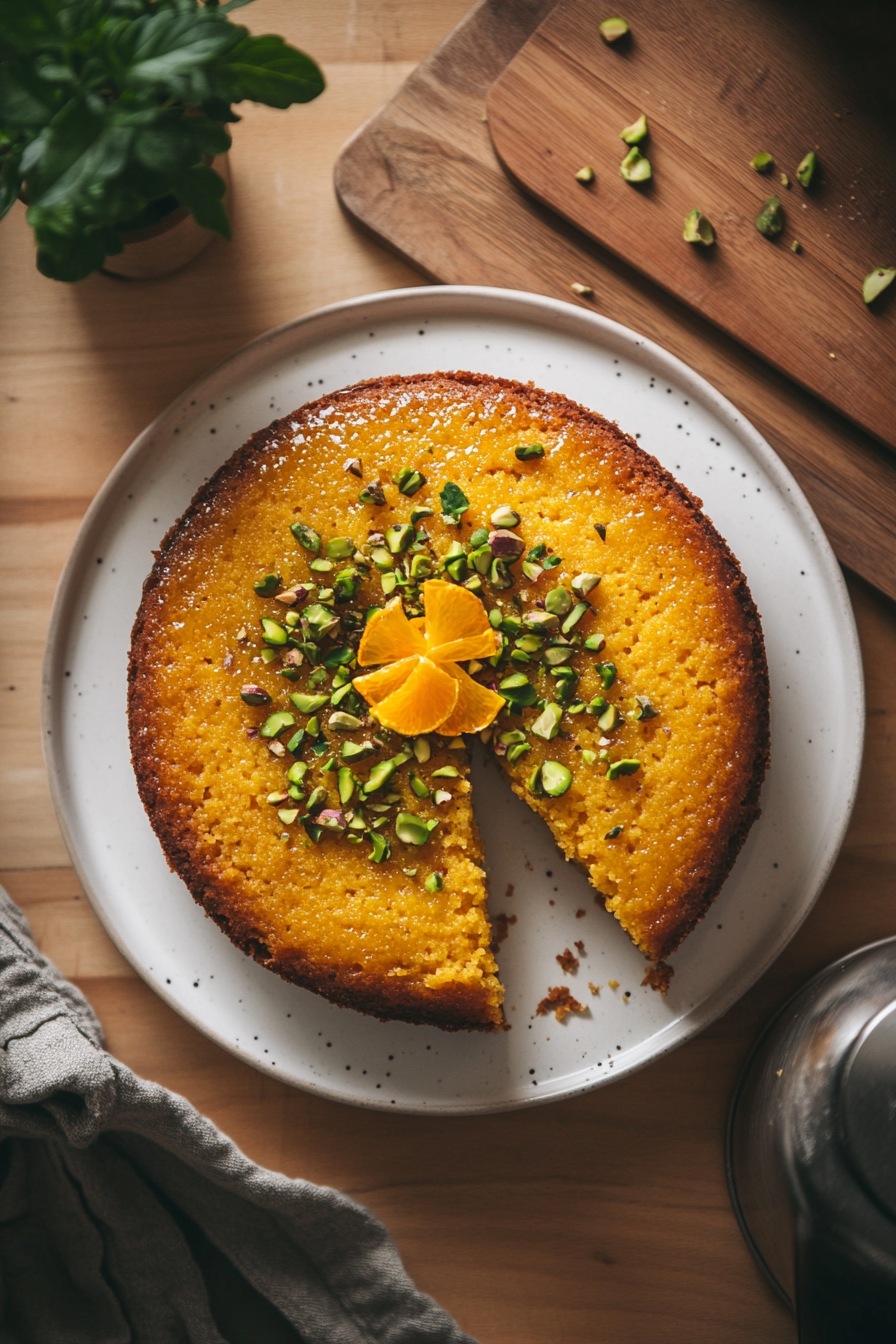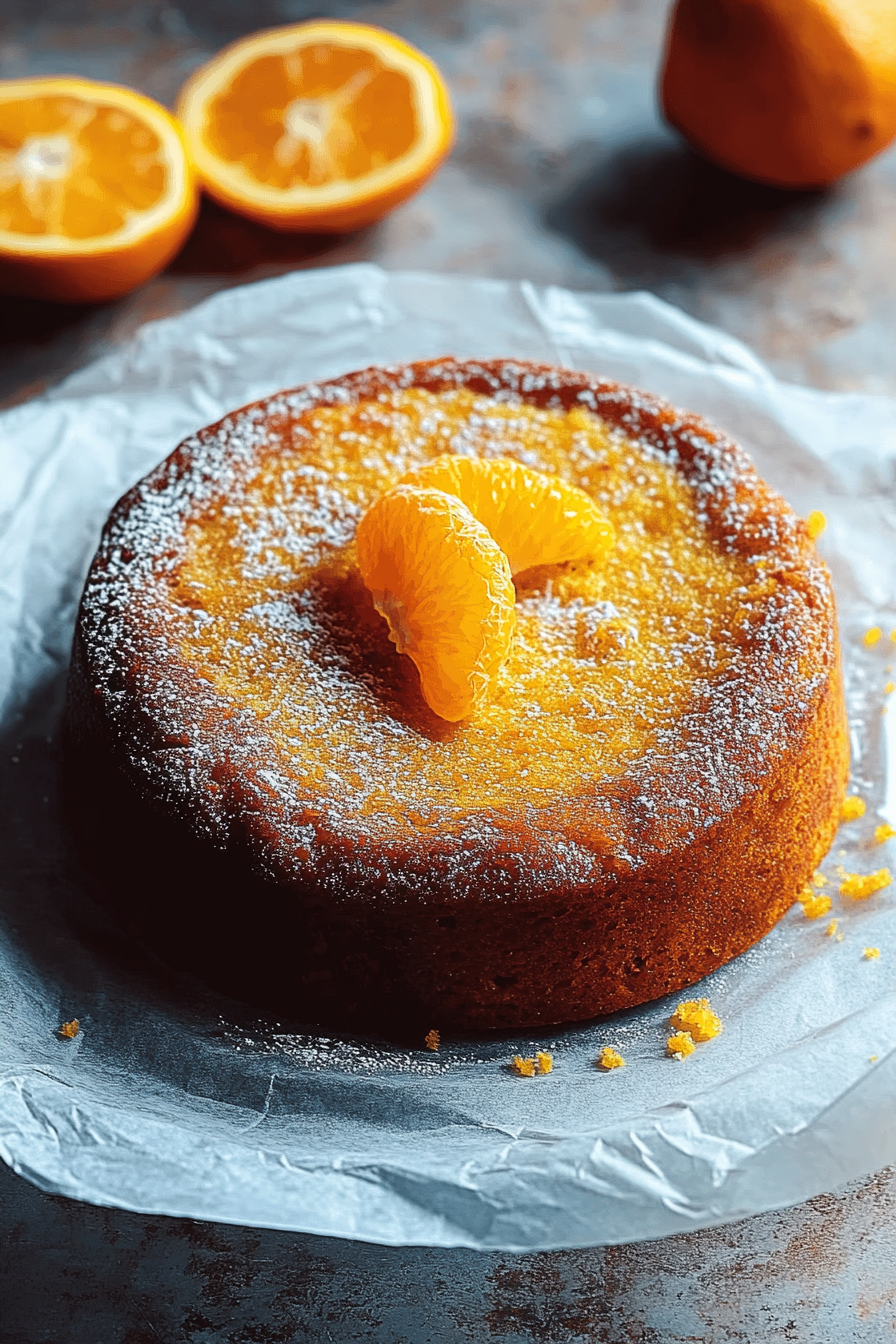Mastering Orange Polenta Cake
The orange polenta cake is a delightful gluten-free dessert that combines the bright, refreshing notes of oranges with the slightly grainy, yet moist texture of polenta. This cake stands out for its rich, fruity flavor balanced by the toasted almond undertones, making it a perfect treat for any occasion. Whether you are a beginner baker or an experienced one, this recipe offers a straightforward approach to creating a luscious cake that’s both satisfying and wholesome.
Its simplicity is one of its greatest benefits. With uncomplicated ingredients like butter, eggs, and citrus fruits, the orange polenta cake is easy to prepare yet impressive in flavor. The use of finely ground polenta adds a unique texture, while ground almonds contribute subtle nuttiness and moistness without the need for heavy flour. This makes it ideal for people who are avoiding gluten or looking for a dessert with a less conventional but delicious twist.
Beyond its delightful taste, this cake is naturally gluten-free and can be adapted for dairy-free diets, broadening its appeal among dietary-conscious bakers. Its moist crumb and tender bite, paired with the tangy orange glaze, create a balanced flavor profile that’s not overly sweet, allowing the natural citrus notes to shine.
For readers interested in creating an elegant, fruity cake that doesn’t require complicated techniques or obscure ingredients, mastering the orange polenta cake is a rewarding experience. It’s a bright alternative to regular cakes and offers versatility in serving options—perfect with crème fraîche, yogurt, or even lemon ice cream.

Jump To
- 1. Mastering Orange Polenta Cake
- 2. Benefits and Advantages of Orange Polenta Cake
- 3. Essential Ingredients for Orange Polenta Cake
- 4. Dietary Substitutions to Customize Your Orange Polenta Cake
- 5. How to Prepare the Perfect Orange Polenta Cake: Step-by-Step Guide
- 6. Mastering Orange Polenta Cake: Advanced Tips and Variations
- 7. How to Store Orange Polenta Cake: Best Practices
- 8. Nutritional Value of Orange Polenta Cake
- 9. FAQs: Frequently Asked Questions About Orange Polenta Cake
- 10. Moist & Easy Gluten-Free Orange Polenta Cake Recipe: A Delightful Fruity Treat
Benefits and Advantages of Orange Polenta Cake
Simple Preparation Meets Exceptional Taste
The orange polenta cake is praised for its straightforward preparation method. Creaming butter and sugar, mixing with eggs, and folding in dry ingredients creates a batter that is easy to handle, making it suitable for home cooks at all skill levels. It does not require advanced baking tools or techniques, and the baking time is manageable within any busy schedule, such as that of working professionals or parents.
Gluten-Free and Dietary Friendly
Polenta, also known as cornmeal, is naturally gluten-free, which makes this cake an excellent option for those with gluten intolerance or celiac disease. The combination with ground almonds adds moisture and richness without gluten. This is a perfect choice for those searching for tasty gluten-free desserts without sacrificing texture or flavor.
In addition, the recipe allows easy swaps to cater to vegan or dairy-free preferences, broadening its accessibility.
A Nutrient-Rich Citrus Boost
Oranges bring vibrant flavor and a dose of vitamin C, fiber, and antioxidants to the cake. Including both zest and juice amplifies the citrus aroma and infuses the cake with bright, fresh notes. For readers curious about the benefits of oranges in your diet, this cake offers a delicious way to incorporate this nutritious fruit into your meals.
Texture and Flavor Complexity
- Polenta’s gentle graininess provides an interesting texture contrast.
- Ground almonds enhance moistness and add a subtle nuttiness.
- Orange glaze offers a sweet, tangy finish that seeps into the cake, improving its moisture and flavor layering.
Why It Stands Out
Compared to traditional flour cakes, the orange polenta cake has a unique crumb and lively citrus flavor that make it memorable and refreshing. Its adaptability to various diets and simple ingredient list make it a go-to dessert that can be enjoyed by many. For other creative dessert ideas worth trying, check out our banana bread cake with cream cheese frosting recipe.

Essential Ingredients for Orange Polenta Cake
Below is the full list of ingredients required to prepare a delicious orange polenta cake, including options for gluten-free and optional flavor enhancements. Understand the role of each ingredient helps grasp how they contribute to the cake’s texture and flavor.
| Ingredient | Quantity | Purpose / Notes |
|---|---|---|
| Unsalted butter | 250 grams | Provides richness, moisture, and texture to the cake |
| Caster sugar | 250 grams | Adds sweetness and helps create a light, fluffy texture |
| Large eggs | 4 | Bind ingredients, add moisture and structure |
| Finely ground almonds or almond flour | 140 grams | Adds subtle nutty flavor and moisture; gluten-free contributor (Almonds nutritional value and health benefits) |
| Polenta (finely ground) | 200 grams | Primary gluten-free base adding grainy texture and body (How to use polenta in recipes) |
| Gluten-free baking powder | 2 teaspoons | Leavening agent for rise, gluten-free to suit dietary needs |
| Orange zest | From 2 oranges | Enhances bright citrus aroma and flavor |
| Orange juice | Juice of 2 oranges (reserve 100 ml for glaze) | Incorporates fresh citrus flavor and moistens the batter |
| Vanilla extract (optional) | 1 teaspoon | Adds warm, sweet aroma complementing orange zest |
| Orange blossom water (optional) | 1 teaspoon | Introduces floral notes for enhanced flavor complexity |
Orange Glaze Ingredients
- 100 ml reserved orange juice
- 100 grams caster sugar or 2 tablespoons honey (adjust for sweetness)
This glaze is drizzled on the cake after baking to add a glossy finish and extra citrus sweetness, helping keep the cake moist and flavorful.
Dietary Substitutions to Customize Your Orange Polenta Cake
The orange polenta cake recipe lends itself well to various dietary preferences and ingredient availability. Below are suggested substitutions to meet common dietary needs or personal taste preferences:
Dairy-Free Options
- Replace the 250 grams of unsalted butter with 3/4 cup light olive oil or vegan margarine for a dairy-free version without compromising moisture.
- Use honey in the glaze or opt for maple syrup to keep it vegan.
Vegan Adaptations
- Substitute eggs with flax eggs (1 tablespoon ground flaxseed mixed with 3 tablespoons water per egg), allow the mixture to thicken before using.
- Use vegan butter or oil as above.
- Ensure baking powder is vegan-friendly.
Gluten-Free Assurance
Using finely ground polenta (cornmeal) and gluten-free baking powder naturally keeps the cake gluten-free. Always confirm ingredient labels if celiac disease requires strict avoidance.
Sugar Alternatives
- Replace caster sugar with coconut sugar or a granulated erythritol blend for lower glycemic impact.
- Adjust sweetness in the glaze using honey or agave syrup, balancing according to preference.
Nut-Free Modifications
If nut allergies are a concern, ground almonds can be omitted or replaced with an equivalent amount of gluten-free flour such as rice or oat flour, but note this may alter the cake’s moistness and texture.
Additional Flavor Twists
Feel free to add spices like ground cardamom or cinnamon into the batter to add depth, or garnish with chopped pistachios or other favorite nuts for extra texture and color.
“Adapting recipes helps everyone enjoy delightful dishes tailored to their dietary needs without losing the joy of cooking.”—Camille Hayes

How to Prepare the Perfect Orange Polenta Cake: Step-by-Step Guide
Creating the moist & easy orange polenta cake is a rewarding baking experience that results in a wonderfully textured, fruity treat. Follow these detailed steps to make sure your cake turns out perfect every time.
First Step: Prepare Your Baking Environment
- Preheat your oven to 160°C (140°C fan) or gas mark 3 (320°F for gas mark 2½).
- Line a 23 cm round cake tin with baking parchment or grease an 8-inch/20 cm springform pan to prevent sticking.
Second Step: Make the Cake Batter
- Cream together 250 grams of unsalted butter and 250 grams of caster sugar until the mixture becomes light and fluffy.
- Add 4 large eggs one at a time, mixing thoroughly after each addition for even distribution.
- In a separate bowl, combine 140 grams of finely ground almonds (or almond flour), 200 grams of finely ground polenta, and 2 teaspoons of gluten-free baking powder.
- If you’d like, add 1 teaspoon of vanilla extract and 1 teaspoon of orange blossom water to the dry mix for additional aroma.
- Gradually mix the dry ingredients into the butter and sugar mixture.
- Fold in the zest of 2 oranges and the juice of 2 oranges, reserving 100 ml of juice for the glaze.
- Pour the batter into your prepared tin and spread it evenly.
Third Step: Baking Process
- Bake the cake in the preheated oven for 40 to 50 minutes.
- Test the cake’s readiness by inserting a skewer into the center; it should come out clean.
- Once baked, let the cake cool in the tin for 10 minutes.
- Carefully turn the cake out onto a wire rack and allow it to cool completely.
Fourth Step: Prepare the Orange Glaze
- In a saucepan, heat the reserved 100 ml of orange juice with 100 grams of caster sugar or 2 tablespoons of honey, adjusting sweetness as preferred.
- Bring to a boil, then reduce heat and simmer for 8 to 10 minutes until the mixture thickens slightly.
- Allow the glaze to cool before drizzling it over the cooled cake.
Fifth Step: Finishing Touches and Serving
- Use a skewer to poke small holes in the cake to help the glaze soak in deeply.
- Optionally garnish with extra orange zest, cardamom pods, or chopped pistachios for color and texture.
- Serve the cake alongside crème fraîche, yogurt, or lemon ice cream for a delightful combination.
For a clear and thorough guide on baking, visit this banana bread cake recipe that offers similar stepwise instructions to build your confidence in the kitchen.
Mastering Orange Polenta Cake: Advanced Tips and Variations
Tips for Success
- Choose the right polenta: Use finely ground polenta to avoid a gritty texture in your cake. Learn more about how to use polenta in recipes.
- Butter temperature: Ensure your butter is softened but not melted for optimum creaming with sugar, which traps air and creates a lighter cake.
- Do not overmix: When combining wet and dry ingredients, fold gently to keep the batter aerated and maintain a tender crumb.
- Use fresh oranges: Fresh zest and juice maximize the vibrant citrus flavor. Supplement with a splash of orange blossom water for subtle floral notes.
- Handle with care: The cake is fragile when warm; avoid moving or slicing until fully cooled to prevent crumbling.
Variations to Try
| Variation | Description | Flavor or Texture Impact |
|---|---|---|
| Chocolate Orange | Add 100 grams of chopped dark chocolate or cocoa powder | Rich, deeper sweetness balancing the citrus brightness |
| Almond Cardamom | Include 1/2 teaspoon ground cardamom and substitute some orange zest with chopped almonds | Spiced warmth enhancing the nutty texture |
| Citrus Mix | Use zest and juice from a mix of oranges, lemons, and limes | Complex and tangy citrus profile with added freshness |
| Dairy-Free | Use 3/4 cup light olive oil or vegan margarine instead of butter | Moist texture suitable for dairy-free diets |
Experimenting with these variations can add new dimensions to your baking repertoire. For more creative dessert ideas, check out cranberry pistachio fudge that blends nuttiness with fruit.
How to Store Orange Polenta Cake: Best Practices
Storing at Room Temperature and Refrigeration
After the cake has completely cooled, store it covered at room temperature in an airtight container. This method keeps the cake moist and fresh for up to 4-5 days.
If your kitchen is warm or humid, consider refrigerating the cake wrapped tightly with plastic wrap and placed in a sealed container. Bring the cake to room temperature before serving to restore its texture and flavor.
Freezing Guidelines
This cake freezes well for up to one month. To freeze:
- Allow the cake to cool completely.
- Omit any garnishes before freezing.
- Wrap the cake tightly in cling film followed by aluminum foil to prevent freezer burn.
- Thaw in the refrigerator overnight or at room temperature for a few hours.
- Add fresh garnishes after thawing for best presentation.
Tip: Cut the cake into portions before freezing for easy defrosting of individual servings.
Nutritional Value of Orange Polenta Cake
This orange polenta cake provides a satisfying treat with balanced nutrition. Below is the approximate nutritional content per serving:
| Nutrient | Amount per Serving |
|---|---|
| Calories | 452 kcal |
| Fat | 23 g |
| Saturated Fat | 14 g |
| Carbohydrates | 55 g |
| Sugars | 37 g |
| Protein | 6 g |
| Fiber | 1 g |
| Salt | 0.5 g |
The use of ground almonds contributes essential nutrients like healthy fats and protein, while the oranges provide vitamin C and antioxidants. Learn more about the almonds nutritional value and health benefits and the benefits of oranges in your diet.

FAQs: Frequently Asked Questions About Orange Polenta Cake
What is an orange polenta cake?
Orange polenta cake is a moist, gluten-free cake made primarily with ground almonds, polenta (cornmeal), butter, sugar, eggs, and fresh orange zest and juice. It has a tender crumb with a pleasant grainy texture from the polenta and a bright citrus flavor that makes it distinct from traditional flour-based cakes.
How do I make an orange polenta cake at home?
To make orange polenta cake, cream butter and sugar, add eggs, then mix in ground almonds, polenta, baking powder, and orange flavorings. Bake at a low temperature until set. After cooling, drizzle with an orange glaze made from juice and sugar. This recipe requires basic equipment like mixing bowls, an electric mixer, and a cake tin. For full step-by-step instructions, visit the detailed recipe guide above.
Can I make an orange polenta cake gluten-free?
Yes, this recipe is naturally gluten-free if you use gluten-free baking powder and finely ground polenta. Polenta is a corn product that contains no gluten, making it ideal for gluten-sensitive diets.
What should I serve with orange polenta cake?
Orange polenta cake pairs beautifully with crème fraîche, yogurt, or lemon ice cream. You can also enjoy it with a cup of tea or coffee for an afternoon treat. Adding fresh fruits or a sprinkling of chopped pistachios enhances both taste and presentation.
How do I store orange polenta cake to keep it fresh?
Store the cake in an airtight container at room temperature for up to 5 days, or refrigerate if preferred. It also freezes well for up to one month when wrapped properly. Always bring refrigerated or frozen cake back to room temperature before eating for the best texture.

Moist & Easy Gluten-Free Orange Polenta Cake Recipe: A Delightful Fruity Treat
🍊 Delight in a gloriously moist and fruity dessert with our Gluten-Free Orange Polenta Cake, offering a zesty burst of citrus in every bite.
🍰 Perfect for any occasion, this simple-to-make cake ensures those on gluten-free diets don’t miss out on scrumptious treats!
- Total Time: 1 hour and 5 minutes
- Yield: 10 servings 1x
Ingredients
250 grams butter (unsalted)
250 grams caster sugar
4 large eggs
140 grams finely ground almonds or almond flour
200 grams polenta (preferably finely ground to avoid grittiness)
2 teaspoons gluten-free baking powder
Zest of 2 oranges
Juice of 2 oranges (reserve 100 ml for glaze)
1 teaspoon vanilla extract (optional)
1 teaspoon orange blossom water (optional)
100 ml reserved orange juice
100 grams caster sugar or 2 tablespoons honey (adjust for sweetness)
Instructions
Preheat oven to 160°C (140°C fan) or gas mark 3 (320°F for gas mark 2½). Line a 23 cm round cake tin with baking parchment or grease an 8-inch/20 cm springform pan.
Cream together butter and sugar until light and fluffy. Add eggs one at a time, mixing thoroughly after each addition.
In a separate bowl, combine ground almonds, polenta, and baking powder. If using, add vanilla extract and orange blossom water. Mix dry ingredients into the butter mixture, then fold in orange zest and juice.
Pour batter into the prepared tin, spreading evenly. Bake for approximately 40-50 minutes, or until a skewer inserted in the center comes out clean.
Remove from oven and let cool in the tin for 10 minutes before turning out onto a wire rack to cool completely.
Heat reserved orange juice and sugar (or honey) in a saucepan. Bring to a boil, then reduce heat and simmer for 8-10 minutes until slightly thickened. Let cool, then drizzle over the cooled cake.
Poke small holes in the cake with a skewer to allow glaze absorption. Garnish with additional orange zest, cardamom pods, or pistachios if desired. Serve with crème fraîche, yogurt, or lemon ice cream.
Notes
👐 Handle the cake gently when warm, as it is fragile.
🥶 The cake can be stored covered at room temperature or refrigerated for 4-5 days; bring to room temperature before serving.
❄️ For a dairy-free version, substitute butter with 3/4 cup light olive oil or vegan margarine.
- Prep Time: 20 minutes
- Cook Time: 45 minutes
- Category: Dessert
- Method: Baking
- Cuisine: International
- Diet: Gluten-Free
Nutrition
- Serving Size: 1 slice
- Calories: 452 kcal
- Sugar: 37 g
- Sodium: 0.5 g
- Fat: 23 g
- Saturated Fat: 14 g
- Carbohydrates: 55 g
- Fiber: 1 g
- Protein: 6 g







